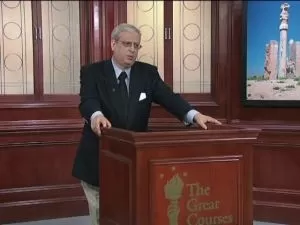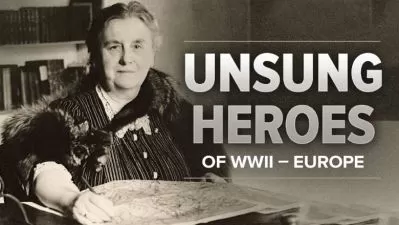The American West: History, Myth, and Legacy
Patrick N. Allitt
13:13:44
Description
The brutal conflict of cowboys and Indians. Dusty, dangerous outposts policed by vigilante justice. The six-shooter showdown at high noon. Daring railroad heists and arduous cattle drives. These and other scenes from countless Western films have so shaped our conception of the American West that it’s impossible to separate myth from reality. But how wild was the West? Was it really ever “won”?
According to historian and award-winning Professor Patrick N. Allitt of Emory University, the historical approach to understanding the American West has moved far beyond pop culture in recent years. “Nearly all the clichés and bromides of the old Western history have been discarded,” he says. “We’re now much more aware of the histories, not just of the people who happened to end up on top—but also the histories of the diverse peoples who were defeated or displaced.”
It turns out that the legendary people and events we associate with the Wild West—the last stand at the Alamo, the Battle of Little Bighorn, the exploits of Calamity Jane and Kit Carson, the glories and hardships of the Gold Rush and the Oregon Trail—are just as exciting in the light of history as the tall tales that have defined our conception of them.
Explored chronologically, they form a story more thrilling than any Hollywood Western. And it’s a story not just of adventure and danger but a story about how the United States, as it acquired new territories and encountered new peoples, transformed a collection of newly independent states into a continent-bestriding colossus that would dominate the 20th century.
Designed to shine a light on truths about westward expansion and the American frontier (sometimes uncomfortable, always insightful), The American West: History, Myth, and Legacy is a way for you to experience the grit and grandeur of an epic period in American history. Professor Allitt’s 24 lectures, rich with historical detail, take you from the era of the American Revolution to the beginning of the 20th century and uncover new historical angles and perspectives about events and themes ranging from the Lewis and Clark expedition to the Indian Removal Act to the creation of America’s first national parks. Packed with period maps and artwork, photographs, diary entries, and more, this course is an entertaining, eye-opening, balanced look at the achievements and sufferings of a period and place as important as it was wild.
Over 200 Years of Frontier History
Central to Professor Allitt’s course is dispelling the idea of the American West as a single, monolithic place and idea. There is a great diversity to the American West that it is easy to overlook.
“It’s actually an area almost as big as Europe, incorporating some of the hottest and coldest places in the inhabited world,” says Professor Allitt. “The area we think of as the West today includes mountain ranges, deserts, canyons, badlands and some of the richest, most productive farmland in the world. At different times, it has been inhabited and claimed by indigenous peoples, Spaniards, Frenchmen, Britons, and Americans. Its people today have distinctive voices, clothes, traditions, and music, and they keep alive a distinct set of ideals and attitudes different from those of their fellow Americans back East.”
Befitting an area of such epic scope and diversity, The American West encompasses more than 200 years of history and the most important events, themes, and ideas that form the backbone of the frontier’s reality—and legend. Just some of the major topics you will explore in this course include:
- The Transcontinental Railroad: Perhaps the most defining moment for the American West was 1869, when the two lines of the Transcontinental Railroad met at Promontory Point in Utah. While the system brought more people (including immigrants) and money out west, many sections were built so badly they had to be renewed almost at once.
- The Trail of Tears: Named the “Trail of Tears” by the Cherokee, the forced migration of America’s “Five Civilized Tribes” in the 1830s resulted in the loss of traditional homes in the East in exchange for federal lands out West (referred to as “Indian Territory”). A central figure in this dark moment in American history: President Andrew Jackson.
- Manifest Destiny: This phrase, coined by journalist John O’Sullivan regarding the nation’s claims on the Oregon territory in the 1840s, came to embody the spirit of westward expansion—and the conflicts it provoked. The idea behind Manifest Destiny was that it was America’s God-given right to spread liberty and democracy across the continent.
- The Gold Rush: With the discovery of Californian gold in 1848, the American West, for the first time, became a destination of mass appeal for Americans. With the mad rush for quick wealth, however, came rampant fraud. Prospectors had to learn quickly how to distinguish gold from “fool’s gold” (iron pyrites). The simplest way to do so is now the most iconic: biting it.
- Cowboys and Cattle: After the Civil War, American cowboys herded cattle to railheads across the West, from where they would eventually feed the industrial workers back East. The most famous cattle trail, the Chisholm Trail (named after a half-Cherokee cowboy) spanned over 500 miles between Texas and Kansas, and could take up to two months to traverse.
The West in Popular Culture
A vivid popular culture sprang up around the American West as the area developed. While Professor Allitt uses these lectures to lay bare the often harsh realities of life out west, he also points out how popular culture—books, paintings, films—can help us understand the intimate details of life for everyday men and women. By looking critically at popular depictions of the West, you will:
- Learn about one of the best accounts we have of the cowboy way of life: the 1885 biography A Texas Cowboy, or Fifteen Years on the Hurricane Deck of a Spanish Pony.
- Open an illuminating window into the emotional lives of homesteaders on the Great Plains through novels including My Ántonia and Little House on the Prairie.
- See how paintings by iconic American artist Frederic Remington emphasized the adventurous men who pitted themselves against the landscape of the West.
- Discover how historian Frederick Jackson Turner’s “frontier thesis” (that the frontier defined American democracy) had an immense influence on generations of historians.
- Break down the main plots of Western films and understand how new historical understanding has led to a shift in the genre’s plots and characters.
A Clearer Picture of the Wild West
Over the years, Professor Allitt has brought his incredible historical knowledge and his engaging teaching style to multiple Great Courses popular with our lifelong learners. The American West is no exception to this tradition. Professor Allitt imbues every single lecture not only with insight and knowledge, but with a contagious passion for the American West—both the heroic idea of it and the more complex historical reality.
Additionally, the lectures in The American West are enriched with historic photographs and illustrations, period artworks and maps, and quotes from first-person accounts and history-changing documents.
“Anyone who studies the subject of the American West quickly discovers that the myths sometimes had a more tenacious grip on Westerners’ minds than the realities,” says Professor Allitt. “But with a close look at the facts and how they’ve been stretched and spun over time, the muddled picture of the place that many people have in their minds will become clearer.”
Saddle up for an exciting adventure in learning.
More details
User Reviews
Rating
Patrick N. Allitt
Instructor's CoursesDr. Patrick N. Allitt is Cahoon Family Professor of American History at Emory University, where he has taught since 1988. The holder of a doctorate in history from the University of California, Berkeley, Professor Allitt-an Oxford University graduate-has also taught American religious history at Harvard Divinity School, where he was a Henry Luce Postdoctoral Fellow. He was the Director of Emory College's Center for Teaching and Curriculum from 2004 to 2009, where he looked for ways to improve teaching. In this critical administrative position, he led workshops on a wide variety of teaching-related problems, visited dozens of other professors' classes, and provided one-on-one consultation to teachers to help them overcome particular pedagogical problems. Professor Allitt was honored with Emory's Excellence in Teaching Award and in 2000 was appointed to the N.E.H./Arthur Blank Professorship of Teaching in the Humanities. A widely published and award-winning author, Professor Allitt has written several books, including The Conservatives: Ideas and Personalities throughout American History; Catholic Intellectuals and Conservative Politics in America, 1950-1985; Catholic Converts: British and American Intellectuals Turn to Rome; and Religion in America since 1945: A History. He is also author of I'm the Teacher, You're the Student: A Semester in the University Classroom, a memoir about one semester in his life as a university professor. In addition, he is the editor of Major Problems in American Religious History. He has written numerous articles and reviews for academic and popular journals, including The New York Times Book Review.

The Great Courses
View courses The Great Courses- language english
- Training sessions 26
- duration 13:13:44
- English subtitles has
- Release Date 2023/04/29
















